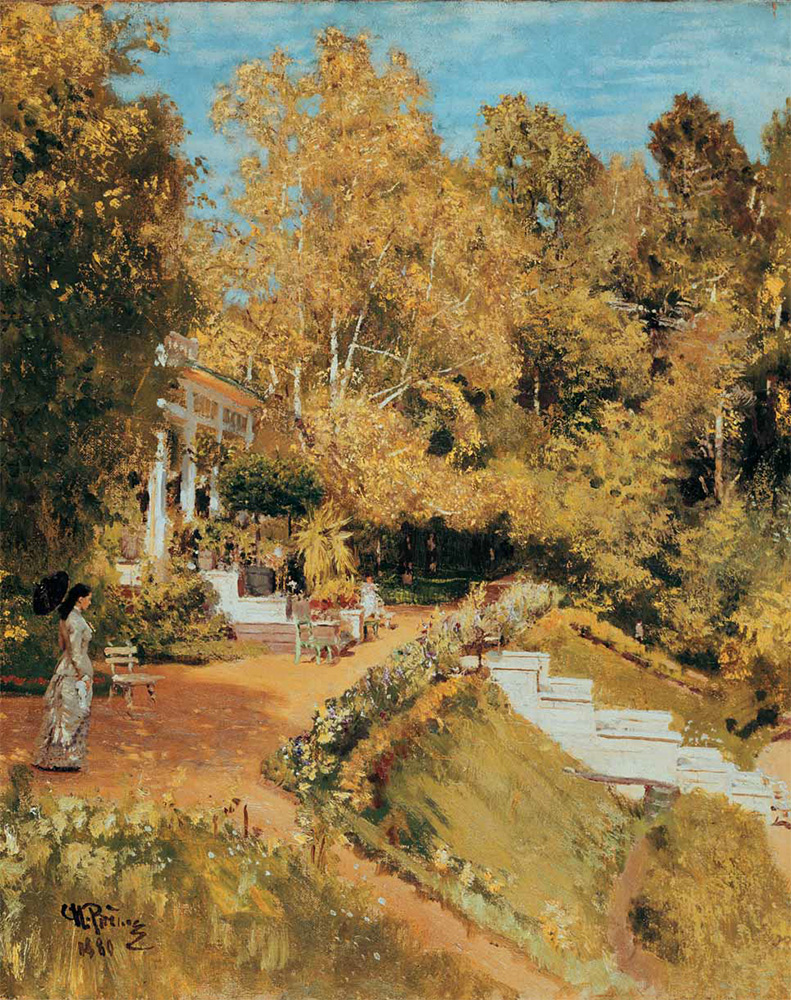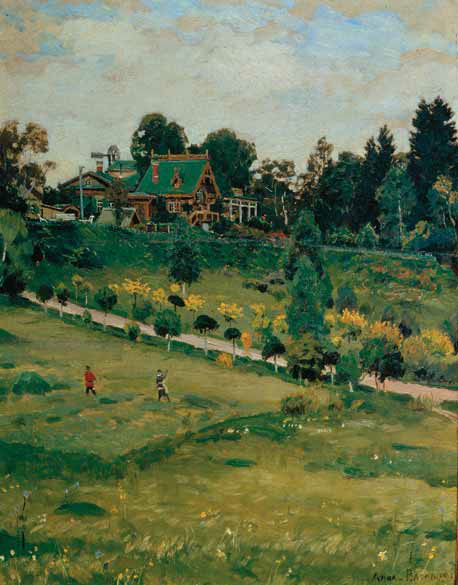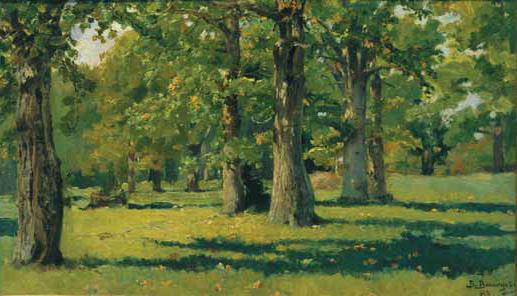Conversation with Nature in Abramtsevo
The Abramtsevo circle of artists was formed in the last third of the 19th century. It grew up around the wealthy manufacturer and patron of the arts Savva Mamontov, and came to include such artists as Ilya Repin, Vasily Polenov, Viktor and Apollinary Vasnetsov, Mark Antokolsky, Valentin Serov, Konstantin Korovin, Yelena Polenova, Mikhail Nesterov, Ilya Ostroukhov and Mikhail Vrubel. Active in many areas such as painting, sculpture and graphic art as well as drama, architecture, decorative and applied arts, the group received wide acclaim.
Its members worked in potteries and carpentry workshops in Moscow and Abramtsevo, designed sets and costumes for their own dramatic productions, as well as those of Mamontov's Private Russian Opera, and even took part in the building of the "Spas Nerukotvorny” (Saviour Not Made by Human Hands) church in Abramtsevo. All this helped them to master new techniques which led to the development of the neo-Russian style.

Ilya REPIN. Abramtsevo. 1880
Oil on canvas. 52.2 by 49 cm. Vasily Polenov Museum
Re-thinking the very role of art and the relationship between art and life, the Abramtsevo group was the first to turn to the decorative arts and crafts. This was a new phenomenon at the time: seeking new stylistic solutions, the artists found them in the creative re-working of popular motifs and old Russian themes. Paintings created in Abramtsevo also reflect a number of new tendencies; these stem from both the general artistic movement at the time and from the group itself, the creative atmosphere it engendered and the interaction and mutual influence of its members. The landscapes created by the Abramtsevo artists clearly bear testimony to both.
The group painted in the Mamontovs' comfortable Moscow home as well as their country residence at Abramtsevo, near Moscow. The old Abramtsevo estate had previously been owned by the writer Sergei Aksakov. Set in a typical "middle Russian" countryside, Abramtsevo was an ideal location for landscape painting. Its picturesque views engaged the artists in "lively conversations with nature"[1], inspiring them to paint prolifically. Abramtsevo came to be known as the "Russian Barbizon".
Like Barbizon, Abramtsevo was a constant source of inspiration to those who painted there and, like Barbizon, it became famous through their work. Furthermore, it is very likely that Repin and Polenov, working in France with scholarships in the 1870s, had precisely such a Barbizon-type artists' colony in mind when they accepted Savva Mamontov's invitation to return to Moscow and form a new art centre in Moscow and Abramtsevo.
At the same time, the comparison between Barbizon and Abramtsevo was never made by Repin, Polenov or Viktor Vasnetsov - the first artists to come and paint there. Neither was the parallel drawn by the artists who followed in the 1880s and 1890s. Repin affectionately called Abramtsevo "the best dacha in the world"[2]. Besides being attracted by the natural beauty of its surroundings, the painters enjoyed spending time with their hosts Savva and Elizaveta Mamontov. The couple's Moscow home and country estate became centres of creative endeavour, places where ideas were shared, new methods tested and common interests developed. The Abramtsevo circle of artists eventually became known as an artistic colony "centring around an estate"[3].
The atmosphere at Abramtsevo was friendly and relaxed. As well as working together, artists spent their leisure time in each others' company, devising pleasant and imaginative pastimes such as drama productions, readings from various authors and other entertainments. All this could not help but influence their painting and particularly their landscapes.
Repin's late 1870s-early 1880s works, such as "The Boundary" (1879, State Tretyakov Gallery) and "Abramtsevo" (1880, the Polenov Museum), exude the carefree spirit of country life and artistic freedom. In these canvases, created in Abramtsevo, the artist uses open-air painting techniques acquired in Paris.
The Abramtsevo estate and its surroundings also feature in dozens of landscapes and sketches by Vasily Polenov. The artist's Abramtsevo works are filled with the same sense of peace, the same musings on the old way of life as his famous "Moscow Courtyard" (1878) and "Grandmother's Garden" (1879), both in the State Tretyakov Gallery. Yet in the Abramtsevo landscapes, the link between the artist and nature intensifies, becomes more intimate; all intermediaries vanish as people gradually disappear from Polenov's paintings. Yet the spiritual element so characteristic of the artist remains: Polenov's landscapes continue to be imbued with emotion ("The River Vorya at Abramtsevo" (1880), "The River Vorya" (1881), and "The Upper Pond at Abramtsevo" (1882), all in the Abramtsevo Museum).
This evolution in Polenov's landscape is likewise evident in the artist's theatre work. In his "Atrium" for Apollon Maikov's "Two Worlds" (1879), Polenov uses his open-air experience to create an ancient courtyard bathed in airy light. Several years later, in the "Castle Staircase" set for Savva Mamontov's "Red Rose" (1883), he creates a moonlight effect by intensifying light and contrast with broad light patches and reflections. Adapting itself to the stage, Polenov's open-air technique evolves into a more decorative approach, an experience reflected in his paintings and sketches. In the late 1880s, the style of Polenov's "unpeopled" landscapes begins to change: forms grow and become broader, less detailed, although the artist still likes to keep a few little mysterious corners and to mingle background and foreground. "Autumn in Abramtsevo" (1890) is the culmination of this type of landscape. Rich, decorative and diverse, its rhythm and composition are highly organised, each detail precisely in place.

Apollinary VASNETSOV. Abramtsevo (a sketch). 1884
Oil on wood. 31.5 by 24.7 cm. Abramtsevo Museum
The old house and countryside at Abramtsevo are repeated in hundreds of open-air sketches and landscapes by such artists as Alexander Kiselev, Ilya Ostroukhov, Viktor and Apollinary Vasnetsov, Yelena Polenova, Konst-antin Korovin and Mikhail Nesterov. These are not obviously striking views, and there are no particularly pretty motifs. Yet the paintings possess an emotional power which comes from the artists' tireless and fond observation of nature, its states and shifts. The subject itself, which had used to constitute the painters' chief anxiety, gradually began to lose its importance; instead, the artists' emotional response to nature and their skill in expressing this response became paramount. The many lyrical sketches and landscapes created in Abramtsevo saw the development of qualities which, as Fyodorov-Davydov noted, "came to be known as 'truth of vision' and 'mood' in landscape painting"[4].

Viktor VASNETSOV. Oak Grove in Abramtsevo. 1883
Oil on cardboard. 36 by 60 cm
State Tretyakov Gallery
The desire to capture fleeting impressions and render motion led artists to work from life, sometimes hastily and impulsively, and the constant honing and refining of open-air painting brought about the emergence of an Impressionist element in Russian art. This is clearly evident in the work of Serov ("Pond at Abramtsevo" and "Winter in Abramtsevo" (1886), both in the State Tretyakov Gallery) and the paintings and theatre work of Korovin.
In Abramtsevo, the artists were constantly outdoors, contemplating and exploring nature. Perhaps the Abramtsevo way of life encouraged another tendency not uncommon in art at that time - the mingling of genres. In Abramtsevo, landscape elements acquired a new meaning, an increased emotional significance. The so-called "landscape-painting" genre was developed primarily in Abramtsevo. Examples include Repin's "The Boundary" (1879, State Tretyakov Gallery), "On the Park Bridge" (1879, State Museum of Fine Art, Museum of Private Collections) and "Abramtsevo", as well as Polenov's "In a Boat" (1880, Kiev Museum of Russian Art). The life of the country estate with its habits and inhabitants had never before come under such close scrutiny in Russian art. Painters sought to portray their impressions of country life and the subtle changes that took place in a country house throughout the day, throughout the year. Lyrical contemplation, the joy of a beautiful summer's day, the elegiac sadness inspired by autumn's decay, the advent of winter - all this was closely examined and re-considered. Later, the theme of the country estate would be taken up by Viktor Borisov-Musatov, Stanislav Zhukovsky and the "World of Art" painters. The aesthetics of the past, the olden days, and life on the Russian country estate were to become an important motif in that movement.
The local landscape was also reflected in numerous portraits created in Abramtsevo. Nature plays an important part in canvases such as Repin's "Portrait of S. Mamontova" (1879), Viktor Vasnetsov's "Portrait of Vera Mamontova" (1896), both in the Abramtsevo Museum, and Serov's "Girl with Peaches" (1887, State Tretyakov Gallery). Landscape is an integral part of this famous portrait of Verushka Mamontova, an important elem-ent of its imagery, and the artist's aim - to render the "freshness of a first impress-ion" - is akin to the task of a "mood landscape" painter.
In late 19th-century Russian art, the tendency emerged to treat all subjects as landscape. The landscape painting approach took over other genres[5], a process which was particularly active in Abramtsevo. In illustrating myths and fairytales, for instance, artists paid particular attention to landscape. In 1881, Viktor Vasnetsov's famous "Alyonushka" (now in the State Tretyakov Gallery) was created in Abramtsevo. Offering his own original interpretation of the story of Alyonushka and her brother Ivanushka, Vasnetsov used motifs taken from nature to create a poetic image of deep sorrow. He renders the sadness of the year's decline, the air of autumnal decay pervading the Abramtsevo countryside.
In 1881, the artist designed the sets for a staging of Alexander Ostrovsky's "Snegurochka" (The Snow Maiden) at Abramtsevo. In the Prologue, the audience is transported to Berendey's magical kingdom. A highly stylised view of the local countryside serves to create a fairytale world. Later, Vasnetsov was to design the sets for Rimsky-Korsakov's opera "Snegurochka" performed by the Mamontov Private Russian Opera. For this 1885 production he used and refined many of the artistic techniques developed whilst working on the earlier, domestic staging of "Snegurochka". The "Berendeyevka Village" set, for instance, is an ornate and highly stylised view of a group of wooden huts decorated with finely traced patterns. In the foreground, a large sunflower nods. The lithe, bright and extremely decorative flower subsequently became a common motif in Art Nouveau.
In 1881 in Abramtsevo Vasnetsov began to work on his "Three Bogatyrs" (Epic Heroes, 1898, State Tretyakov Gallery). His earlier Abramtsevo landscapes "The Vorya Valley near Mutovka" (1880), "The Woods near Akhtyrka" (both in the Abramtsevo Museum) and "Landscape near Abramtsevo" (1881, State Tretyakov Gallery) reflect the artist's search for imagery appropriate to this subject.
Gradually, Abramtsevo artists had come to see Russian nature in something of a historical light. No longer treated as a portrait, landscape came to be rendered as epic[6].
In Nesterov's "legend-paintings" "The Hermit" (1888-89) and "The Vision of the Young Bartholomew" (1889), both in the State Tretyakov Gallery, the landscape appears still, calm and peaceful. These are views which move one to silent reflection and contemplation. The landscapes of Nesterov's paintings are never merely background material, but instrumental in developing and presenting the main theme of the painting. The solemn landscapes pictured in the artist's "legends" are views of Abramtsevo. In one of his letters, Nesterov wrote: "The mood there [in Abramtsevo] was one of constant elation, and the countryside such, that I could happily spend years in that place, forever discovering new and interesting things, finding more things to love and encountering endless themes for my paintings and sketches..."[7]
The Abramtsevo countryside and old estate with its curious buildings, picturesque park, avenues and flowerbeds appear again and again in Yelena Poleno- va's numerous watercolour studies and fairytale illustrations. Stylised and reworked, they form a fantastical universe - a magic world. In her illustrations Poleno- va strove to express "the poetic view of Russian nature held by the Russian people". She wished to clarify, for herself and others, "in what way the Russian landscape influenced, and was portrayed in, Russian folk epic and lyrical poetry"[8]. In "The Beast" (1890s, Abramtsevo Museum), Polenova fills her canvas in the ornamental manner typical of Art Nouveau. In Abramtsevo, the group paid a great deal of attention to folk art, studying original examples of popular decorative patterns and their formation and development. Polenova then built on this knowledge in her work.
In "The Beast", trees and blooms form a decorative pattern blending natur-ally with the youthful figure picking flowers as well as the rounded form of the monster which, in Polenova's interpret-ation, appears almost picturesque. The sketch for this work had been made in Maria Yakunchikova-Weber's studio in Paris. Its subject puts one in mind of the Abramtsevo production of Savva Mamontov's "Red Rose" (1883) and Nikolai Krotkov's opera "The Red Rose" staged by Mamontov's Private Russian Opera in 1886. Polenova had, in fact, made the costumes for both productions. "The Beast" could be said to possess two important features of Russian Art Nouveau: ornamentation and a strongly theatrical quality[9].
Many of the Abramtsevo circle's ideas were shared and, indeed, put into practice by the artist Maria Yakunchikova-Weber. Polenova's younger studio companion, Yakunchikova showed a strong interest in ornamentation, which in the mid-1890s led her to develop the new technique of pokerwork and oil on wood. According to her method, the motif was first burnt into the wood using pok- erwork. The space within was then filled with oil paint, as in her 1896 "The Fir and the Aspen" (State Tretyakov Gallery). Her closeness to Abramtsevo painters such as Polenova, Korovin and Vrubel and part icipation in the group's creative undertakings were clearly important in shaping Yakunchikova's passion for decorative art.
Mikhail Vrubel was one of the most prolific members of the Abramtsevo group. His talent for decoration led him to become actively involved in the Abramtsevo pottery and in stage design for Mamontov's Private Russian Opera. Among his most striking sets were those designed for Rimsky-Korsakov productions. One does not ordinarily associate Vrubel with landscape painting, yet the Abramtsevo museum boasts a watercolour clearly painted by Vrubel in Abramtsevo from nature or, at the very least, as a result of observing nature. This is the "Decorative Motif with White Lilies" (from the 1890s) - a small work, the painting nonetheless shows Vrubel's ability to transform reality through the power of his imagination. Real impressions develop into fantastical worlds. "I am now back in Abramtsevo," Vrubel wrote to his sister in 1891. "And once again I am overwhelmed - nay, not overwhelmed; once more I hear that intimate national note which I so wish to capture on canvas and in decoration."[10]
That "note", it seems, haunted many artists in Abramtsevo.
One must not forget that the achievements and discoveries of the Abramtsevo group were in part made possible by its patrons, Savva and Elizaveta Mamontov. Thanks to them, a relaxed, friendly, homely and at the same time busy and creative atmosphere reigned there. The artists were constantly aware of it, whether sketching and holding their "lively conversations with nature", preparing a domestic theatre production, working on the Abramtsevo church or busy in the pottery. Of all their wonderful legacy, however, it is the landscapes, the poetic views of the Abramtsevo countryside, which most fully communicate the group's sense of freedom and exaltation.
Abramtsevo is not referred to as a school in the same sense as Barbizon. Nevertheless, it served as a great creative laboratory, promoting the emergence of new methods and ideas in the arts and crafts. As such, its role in the development of Russian art cannot be overestimated.
- Yekaterina Sakharova. «Vasily Dmitrievich Polenov. Yelena Dmitrievna Polenova. Khronika Semyi Khudozhnikov» (Vasily Dmitrievich Polenov. Yelena Dmitrievna Polenova. The Artists Family Chronicle). Moscow, 1964, p.315.
- Eleonora Paston. «Abramtsevo. Iskusstvo i Zhizn» (Abramtsevo. Art and Life). Moscow, 2003, p.385.
- From Repin's letter to Adrian Prakhov, May 1877. Taken from «Repin I.Ye. Khudozhestvennoye Nasledstvo» (Ilya Repin. An Artistic Legacy) in 2 vols. Leningrad, Moscow, 1949, vol.2, p.32.
- Alexei Fyodorov-Davydov. "Russky Peizazh Kontsa XIX - Nachala XX Veka" ("Russian Landscape of the Late 19th - early 20th Century"). Moscow, 1974, p.10.
- Alexei Fyodorov-Davydov. "Russkoye Iskusstvo Promyshlen- nogo Kapitalisma" ("Russian Art at the Time of Industrial Capitalism”). Moscow, 1929, pp. 10, 12.
- Viktor Plotnikov. "Folklor i Russkoye Izobrazitelnoye Iskusstvo Vtoroi Poloviny XIX Veka” ("Russian Folklore and Fine Art in the Second Half of the 19th Century”. Leningrad, 1987, p.149.
- Mikhail Nesterov. "Pisma. Izbrannoye” ("Selected Letters”). Leningrad, 1988, p.306.
- Sakharova, 1964, p.373.
- Fyodorov-Davydov, 1974, p.53.
- Mikhail Vrubel. "Perepiska. Vospominaniya o Khudozhnike" ("Correspondence. Memories of the Artist"). Leningrad, Moscow, 1976, pp. 79-80.
Oil on canvas. 71 by 58 cm
Abramtsevo Museum
Oil on canvas. 73 by 59 cm
Abramtsevo Museum
Oil on canvas. 61.5 by 48 cm
State Tretyakov Gallery
Sketch for a scene from Ostrovsky’s “Snegurochka”. Watercolour and zinc white on paper. 21 by 28 cm
Abramtsevo Museum
Oil on canvas. 20 by 15.5 cm
State Tretyakov Gallery
ГТГ
Sketch for a scene from Mamontov’s “Red Rose”. Watercolour on paper. 25.3 by 33.8 cm
Abramtsevo Museum
Oil on canvas. 160 by 211 cm
State Tretyakov Gallery
ГТГ
Oil on canvas. 89 by 69 cm
Abramtsevo Museum
Oil on canvas. 77.5 by 126 cm
Vasily Polenov Museum
Oil on canvas. 48 by 32 cm
Abramtsevo Museum
Oil on canvas. 91 by 85 cm
Oil on canvas. 32 by 46 cm
Abramtsevo Museum
Oil on canvas. 43.4 by 31 cm
Abramtsevo Museum
Ink, watercolour and zinc white on paper. 21.7 by 32 cm
Abramtsevo Museum
Oil on wood, pokerwork. 60 by 48.5 cm
State Tretyakov Gallery
Gouache on paper. 27.4 by 20.7 cm
Abramtsevo Museum
Oil on canvas on cardboard. 144 by 103 cm
Abramtsevo Museum



























